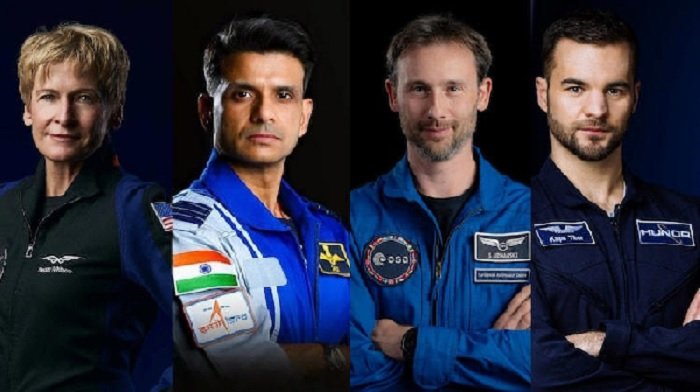India Launches First Astronaut in 41 Years in 2025 by launching its first astronaut into space in over four decades. The last time an Indian citizen went into space was in 1984 when Wing Commander Rakesh Sharma flew aboard a Soviet spacecraft. After a long 41-year hiatus, India has reignited its human spaceflight program, taking a giant leap forward with this groundbreaking mission.
This historic event marks a significant moment not only in India’s space journey but also in global space exploration, showcasing India’s technological growth and aspirations to become a major player in the modern space race.
🇮🇳 A Look Back: India’s First Space Hero, Rakesh Sharma
Before delving into the 2025 achievement, it’s essential to revisit the roots of India’s human space program. In 1984, Rakesh Sharma became the first Indian in space when he flew aboard the Soviet Soyuz T-11 mission. His iconic reply to Prime Minister Indira Gandhi, “Saare Jahan Se Achha,” when asked how India looked from space, became a national treasure.
However, despite Sharma’s successful mission, India didn’t pursue manned missions afterward due to limited resources and focus on other satellite-based programs. The dream of launching Indian astronauts was kept alive through ISRO’s consistent progress in satellite launches and moon missions like Chandrayaan and Mangalyaan.
🚀 India’s Historic 2025 Astronaut Launch: Mission Highlights
✅ Mission Name: Gaganyaan-1
✅ Launch Date: June 2025
✅ Launch Vehicle: GSLV Mk III (nicknamed “Bahubali”)
✅ Astronaut Onboard: Squadron Leader Rajeev Joshi (Indian Air Force)
✅ Mission Duration: 5 days in Low Earth Orbit (LEO)
✅ Launch Site: Satish Dhawan Space Centre, Sriharikota
This mission is part of India’s prestigious Gaganyaan project, a fully indigenous human spaceflight program led by ISRO (Indian Space Research Organisation) in collaboration with DRDO and HAL. The Gaganyaan-1 mission has not only made India the fourth country in the world to send a human to space independently but also sparked global admiration for its technological and budget-efficient execution.
🌍 Why This Mission Matters Globally
The success of India’s astronaut launch resonates beyond national borders for several reasons:
- Emerging Space Superpower: India joins the elite group of space-faring nations like the USA, Russia, and China who have independently launched humans into space.
- Budget Efficiency: India achieved this feat with a mission budget reportedly under ₹10,000 crores, far less than similar Western programs, showcasing its cost-effective engineering capabilities.
- Strengthening Global Ties: India’s growing capabilities in space attract collaboration from global players like NASA, ESA, and SpaceX.
- Inspiring the Youth: The mission has ignited dreams in millions of young Indians, boosting interest in STEM education and careers in science and space research.
🛰️ Behind the Scenes: The Gaganyaan Program
Launched officially in 2018, the Gaganyaan program was delayed by the COVID-19 pandemic and technical challenges but resumed with renewed vigor in 2022. ISRO conducted multiple unmanned test flights, escape system validations, and crew module testing to ensure safety and reliability.
Key components of the Gaganyaan mission:
- Crew Module: Designed to safely house the astronaut with life support systems.
- Service Module: Provides power, propulsion, and life support support.
- Crew Escape System: Ensures quick ejection in case of launch failures.
The rigorous astronaut training took place at ISRO centers and Russia’s Yuri Gagarin Cosmonaut Training Center, focusing on physical fitness, survival training, and simulation exercises.
👨🚀 Meet India’s New Space Hero: Rajeev Joshi
Squadron Leader Rajeev Joshi, an accomplished test pilot with the Indian Air Force, was selected among four astronaut candidates. Trained under extreme conditions and tested for both physical and psychological endurance, Joshi now holds the honor of being the second Indian and the first from independent India’s space program to fly into space.
His background:
- Age: 38
- Education: NDA Graduate, B.Tech in Aeronautics
- Missions flown: 1000+ hours of flying on Su-30 MKI
- Selected by ISRO in 2021 for Gaganyaan
- Nicknamed: “The Calm Comet” by his training team
His return to Earth was marked by national celebrations and global headlines.
🧪 Scientific Experiments Conducted in Orbit
The Gaganyaan-1 mission wasn’t just symbolic; it included several scientific objectives:
- Microgravity Experiments: Studying fluid dynamics and biological samples.
- Space Medicine Research: Monitoring the astronaut’s physiological and psychological responses.
- Satellite Component Testing: Assessing material performance in space conditions.
These results will help future missions, including plans for space labs and possibly a moon mission with human presence.
🇮🇳 What’s Next for India’s Human Spaceflight Program?
India’s space ambitions don’t stop with one astronaut. The future roadmap includes:
- Gaganyaan-2: A two-person crew mission expected by 2027.
- Indian Space Station: ISRO aims to build a small modular station by 2035.
- Moon Mission with Crew: A human lunar mission is part of ISRO’s 2040 vision.
- International Collaboration: Talks with NASA and JAXA for joint astronaut missions and research programs.
📈 Impact on India’s Global Image and Economy
The successful astronaut launch is already yielding dividends:
🔹 International Recognition:
India is now recognized as a reliable partner in space exploration and satellite deployment.
🔹 Boost to Innovation:
Private Indian space startups like Skyroot Aerospace, Agnikul Cosmos, and Pixxel have received more funding and interest after the launch.
🔹 Tourism & Education:
Space museums and training centers are witnessing a surge in visitors, and students are increasingly enrolling in science and aerospace programs.
🔹 Economic Growth:
India’s space sector is projected to be worth $13 billion by 2030, creating thousands of new jobs.
📰 How the World Reacted
The international media hailed the launch as a “turning point” for India:
- BBC: “India Returns to the Stars with Human Mission After 41 Years”
- The Guardian: “A Budget Miracle: India’s Human Spaceflight Success”
- NASA: Extended congratulations, calling it a “milestone for humanity.”
Even tech mogul Elon Musk tweeted: “Congratulations ISRO & India! A big win for global space innovation.”
🗣️ Voices from India
Social media and news outlets were flooded with emotional reactions:
- Students: “We want to be astronauts too!”
- Scientists: “Our hard work has reached orbit!”
- Families: “Proud moment for every Indian!”
The Prime Minister, in his address, called this mission “a proud comeback to space after 41 years”, and dedicated it to India’s youth and scientific minds.





